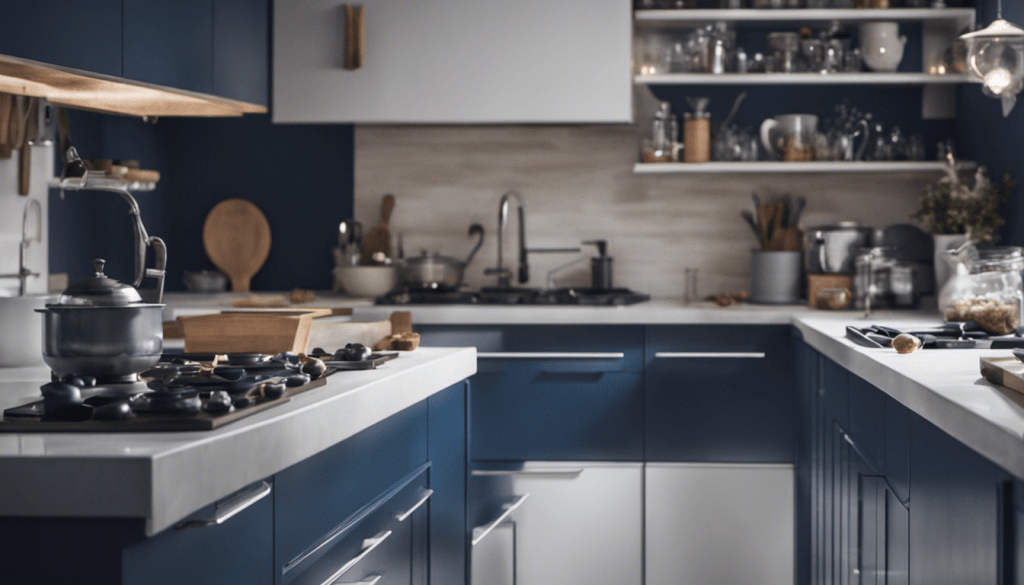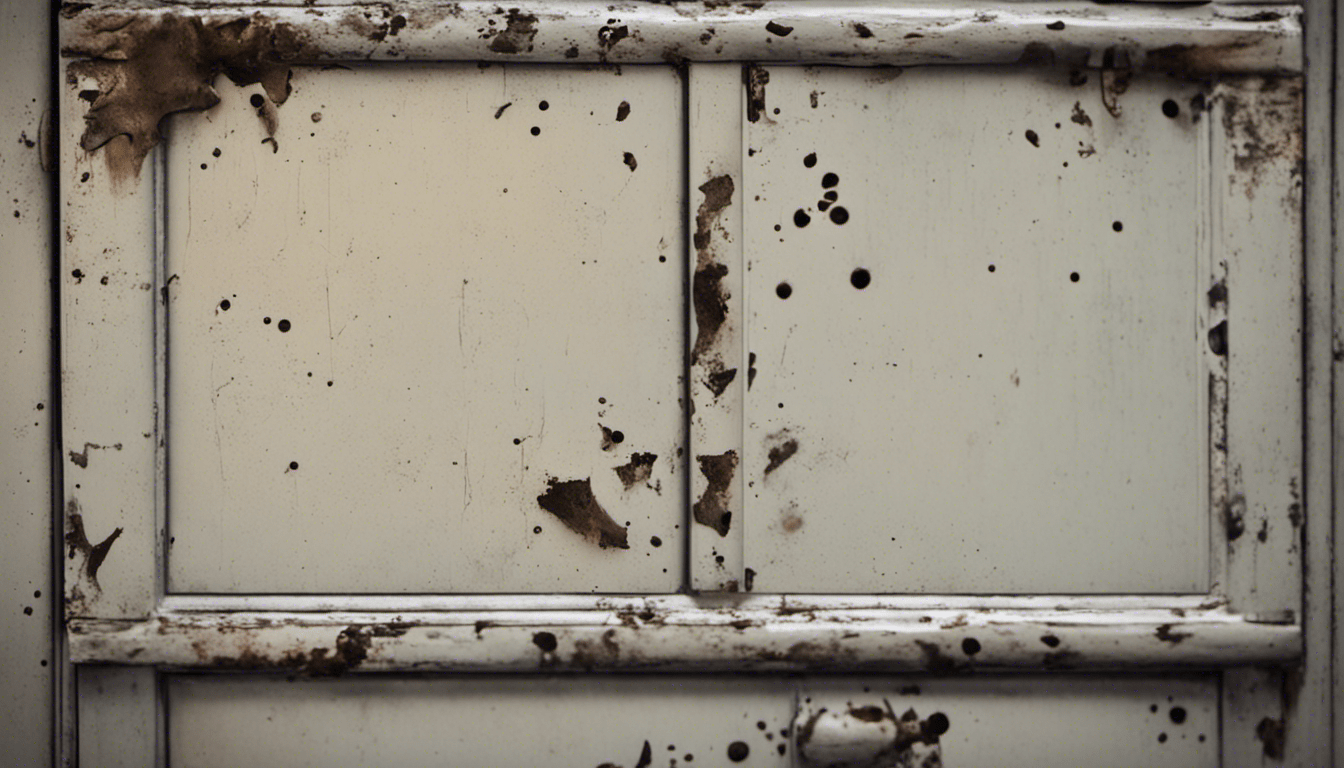You may be wondering why the thickness of the paint matters when painting your kitchen cupboards. After all, paint is paint, right? Wrong!
The thickness of the paint is key to achieving a quality finish and maximum longevity. With the right paint thickness, you can protect your cupboards from scratches, scuffs, and wear and tear.
Read on to learn why paint thickness matters and how you can achieve the best results.
- Key Takeaways
- Benefits of Brush Painting v Spray Painting
- Spray painting kitchen unit problems
- Selecting the Right Paint
- Measuring Thickness microns Spray v Brush applied
- Applying Paint
- Finishing Touches
- Drying Time
- Spray painting kitchen unit problems
- Clean-up Tips
- Troubleshooting
- Frequently Asked Questions
- Key Takeaways
- Benefits of Brush Painting v Spray Painting
- Spray painting kitchen unit problems
- Selecting the Right Paint
- Measuring Thickness microns Spray v Brush applied
- Applying Paint
- Finishing Touches
- Drying Time
- Spray painting kitchen unit problems
- Clean-up Tips
- Troubleshooting
- Frequently Asked Questions
Key Takeaways
- Paint thickness is crucial for ensuring the performance of kitchen cupboard coatings.
- Thicker coatings offer more protection to the cupboard surface.
- Overapplying or underapplying paint can have negative consequences on the durability and appearance of the cupboards.
- Monitoring and maintaining the appropriate paint thickness can help achieve a high-quality finish and prolong the lifespan of the cupboards.
Benefits of Brush Painting v Spray Painting
Brushing your kitchen cupboard is the best way to ensure a perfect paint finish, as it provides better control and coverage than spray painting. There are several advantages to brushing over spraying.
The technique is more precise and allows you to get into tight corners and mouldings, creating a more even coverage. The durability of the finish will be better than a spray finish, as the paint has been applied thicker and with more control.
It also allows you to create more intricate designs and effects, providing aesthetics that spray painting can't. Finally, maintenance is easier with a brush finish, as any minor scratches or chips can be easily touched up.
The biggest difference is at kitchen cupboard painters using brush applied paint in conjunction with paint rollers, we apply a minimum of 6 coats. Spraying kitchen units the typical number of coats used is 2 and the main reason the inevitable chipping and flaking occurs
Spray painting kitchen unit problems
However, if you choose to spray paint your kitchen cupboard, there are several potential issues to consider:
-
Spray vs brush techniques: Spray painting requires a larger investment in equipment and technical skill. If done incorrectly, it can lead to an uneven finish.
-
Common paint application mistakes: Poor preparation of the surface and incorrect application can lead to an uneven finish and paint runs.
-
Achieving a smooth finish: Choosing the right primer and surface preparation techniques are essential for achieving a smooth finish.
-
Choosing the right primer: Selecting the wrong primer can lead to poor adhesion and uneven coverage.
Spray painting kitchen units requires a higher level of investment and skill. However, if done correctly, it can result in a professional finish. Make sure to use the right primer, properly prepare the surface, and apply the paint carefully to avoid common mistakes. Unfortunately most sprayed kitchens do not get the correct preparation. Most of Kitchens Cupboard Painters business come from previously spray finished kitchens.
There's a reason high end kitchen suppliers opt for hand painting by brush their kitchens
Selecting the Right Paint
When selecting the right paint for your kitchen cupboard painting project, it's important to consider the paint's thickness. Durability is an important factor to consider, as thicker paint will provide greater protection and last longer.
Proper surface preparation is also essential for the paint to adhere and last. Make sure to select a color that fits well with the rest of the kitchen and apply the paint using the appropriate techniques.
Depending on the paint you choose, there may be specific maintenance instructions that need to be followed. Taking into account all of these factors will ensure that you choose the best paint for your project and get the most out of your painting job.
Measuring Thickness microns Spray v Brush applied
Have you ever wondered how to measure the thickness of paint applied by spray or brush? To ensure the best finish and coverage, accurate measurement of coating thickness is essential.
Here are four key points to consider when measuring thickness:
-
Wet Film Thickness (WFT) measurements are best completed with the help of Coating Thickness Gauges.
-
Different Coating Application Techniques result in different WFTs.
-
Adhere to Coating Thickness Standards and Specifications to ensure a high-quality finish.
-
Monitor Coating Thickness Measurements during each stage of the project to ensure specification compliance.
Applying Paint
Having discussed the importance of measuring paint thickness and the techniques used, applying paint correctly is the next step in achieving a high-quality finish.
To ensure a uniform coating, use the right paint application techniques and tools. For measuring accuracy, use a coating thickness measurement tool such as a wet film thickness gauge to check the thickness of the paint.
When applying paint, make sure to adhere to the paint thickness standards for the desired product. This will ensure that the coating provides the desired protection and performance.
To avoid under- or over-application of paint, use the right tools and techniques for the job.
With the right preparation and tools, you can achieve a high-quality finish with ease.
Finishing Touches

Once you've achieved the desired paint thickness, it's time to finish the job with a few finishing touches:
- Use a brush application technique to ensure an even coverage.
- Follow paint thickness recommendations to achieve adequate protection.
- Measure wet film thickness with a gauge to ensure accuracy.
- Use coating thickness gauges to measure multiple coats of paint.
To achieve the best results, follow these steps to ensure the paint thickness is right.
Brush application ensures an even coverage while paint thickness recommendations will help you achieve adequate coverage.
A wet film thickness gauge will help you accurately measure the paint thickness, while coating thickness gauges will help you measure multiple coats of paint.
With these tools and techniques, you can ensure you get the best possible results when painting kitchen cupboards.
Drying Time
Drying time is an important factor to consider when painting kitchen cupboards. Measuring accuracy is essential to ensure the desired outcome, and proper equipment recommendations should be followed when surface preparation is done. Drying techniques should be used to avoid any issues arising from the paint job. Troubleshooting tips should be handy to resolve any issues that may occur.
| Factor | Action |
|---|---|
| Measuring accuracy | Essential |
| Equipment recommendations | Follow |
| Surface preparation | Do |
| Drying techniques | Use |
| Troubleshooting tips | Handy |
Spray painting kitchen unit problems
Spray painting kitchen units can be tricky, so it's important to be aware of the potential problems.
-
Not properly preparing the surface
Proper surface preparation is the key to success, as any dirt, grease, or other contaminants will stop the paint from adhering properly. -
Not applying the paint evenly
Achieving a smooth, streak-free finish requires careful attention to detail. -
Not using the right paint for the job
The type of paint also matters, as using a paint designed for wood may not work on kitchen units that are made of metal. -
Not allowing enough time for the paint to dry
It's important to allow the paint adequate time to dry before attempting to add another layer—doing so too soon can lead to streaking or bubbling.
With the proper surface preparation and troubleshooting tips, you can avoid common mistakes and achieve a professional-looking finish.
Clean-up Tips
Once you've finished applying the paint, be sure to clean up any messes to ensure a professional finish. Cleaning techniques are important for surface preparation, paint adhesion, and paint durability.
Immediately remove any excess paint from the cupboard surfaces with a damp cloth. Be sure to use a detergent-free cleaning solution to avoid any damage to the paint.
Once the cupboard is dry, apply a coat of wax or sealant for extra protection. Take the time to inspect the cupboard for any missed spots or uneven coats and touch up as necessary.
Lastly, consider using a maintenance product to help protect the paint from UV damage and keep it looking new for longer.
With these tips, you'll guarantee a beautiful paint job for your kitchen cupboard.
Troubleshooting
If you encounter any issues while painting, such as peeling, cracking, or bubbling, it's important to troubleshoot the problem. Common issues include poor adhesion, insufficient thickness, and improper curing. Here are the steps to take for a successful outcome:
- Identify the common problems.
- Research solutions that address the identified problems.
- Evaluate the common mistakes that could have caused the problem.
- Use the recommended tools to assess the thickness and other factors.
- Implement preventive measures to avoid similar issues in the future.
Troubleshooting requires patience and attention to detail. Taking swift action and using the right tools and techniques will help you get the best results.
Frequently Asked Questions
What Is the Best Way to Prepare the Surface Before Painting?
Sand the surface thoroughly with the right grit sandpaper. Choose a primer that matches your paint sheen. Brush and roll with the right nap for the paint sheen. Use even brush strokes for a smooth finish. Apply multiple thin layers to ensure even coverage.
How Many Coats of Paint Should Be Applied to Achieve a Professional Finish?
For the best results, use masking tape to protect surfaces, select a suitable primer, use a quality brush, keep paint consistency consistent, and use a sanding technique. Apply at least two coats of paint for a professional finish.
Is It Possible to Spray Paint Kitchen Units in Place?
Yes, it is possible to spray paint kitchen units in place. When choosing paint type, primer, sanding techniques and coverage, keep in mind drying time. Make sure to use the right quality, high-adhesion primer and sand surfaces before painting. Carefully measure and apply the paint, being mindful of coverage and thickness.
What Is the Difference Between Brush-Applied and Spray-Applied Paint?
Brush-applied paint requires more preparation, masking, and quantity than spray-applied paint. Select a brush appropriate for the coating type and follow these tips to ensure a quality finish.
Are There Any Special Techniques for Painting Around Handles and Hinges?
For painting around handles and hinges, use masking tape to protect hardware, choose a small-tipped brush, select a paint with good coverage, blend colours to ensure a uniform finish, and use a light sanding technique.
